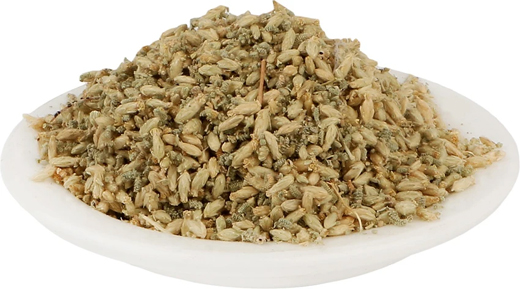Brinjasif (Achillea millefolium) – Uses, Benefits, Dosage & Properties
Abstract
Achillea millefolium, commonly known as yarrow or milfoil, is a member of the Asteraceae family. It is an alpine, high-altitude plant with a circumboreal distribution across the Northern Hemisphere, including regions of Asia, Europe and North America. In India, it is primarily found in the Himalayan regions of Jammu and Kashmir, Himachal Pradesh, and Uttarakhand, at elevations ranging from 1,050 to 3,600 meters. The genus name Achillea is derived from the mythical Greek hero Achilles, while the species epithet millefolium refers to the plant’s finely divided, many-segmented leaves.

Introduction
The name Achillea is associated with Achilles, the legendary hero of the Trojan War depicted in the Iliad, who is said to have used yarrow to treat the wounds of soldiers. For centuries, various species of Achillea have been utilised in traditional medicine. In particular, Achillea millefolium Linn., known locally as Brinjasif, has been used both internally and externally for a wide range of ailments. Internally, it is commonly consumed as an herbal tea to alleviate headaches, liver and biliary disorders, gastrointestinal issues, menstrual irregularities and to stimulate appetite. Externally, it is applied in the form of lotions or ointments to treat skin inflammations, wounds and abrasions. Yarrow has been valued for its medicinal properties since ancient times, especially in traditional and folk medicine systems, where it has long been used as a wound-healing herb.
Scientific Classification
- Kingdom: Plantae
- Order: Lamiales
- Family: Asteraceae
- Genus: Achillea
- Species: Millefolium
Synonyms
- Yarrow
- Blood wort
- Western Yarrow
- Carpenter’s weed
Vernacular Names
- Unani Tibbi – Artemisia, Artiyamasia
- Hindi – Gandna, Gandmaar
- Arabic – Suila, Fafor
- Persian – Brinjasif, Buimaderan
- English – Yarrow, Thousand leaf
- Cutch and Himachal Pradesh – Brinjasif
- Kashmiri – Momadru Chopandiga
Habitat
It is mainly found in Europe, America and various regions of Asia.
Morphology
Achillea millefolium is an erect, slightly aromatic, pubescent perennial herb that typically grows to a height of 15–90 cm. Its leaves, measuring 5–20 cm in length, are bipinnate or tripinnate, giving them a finely divided, feathery appearance and are spirally arranged along the lower and middle portions of the stem. The plant bears flowers that are usually white, though shades of pink or pale purple also occur. These flowers form ovoid, flat-topped clusters at the ends of stems and branches, with densely packed petals creating a flattened inflorescence. The fruit is a small, shiny, oblong achene about 2 mm long, characterised by broadly winged margins. The aerial parts of the plant emit a pleasant, aromatic fragrance.
Therapeutic Properties
- Analgesic
- Antiseptic
- Hepatoprotective
- Antioxidant
- Antimicrobial
- Anti-inflammatory
- Diuretic
- Effective for female reproductive system problems
Systemic Actions
Localised
It can be applied locally as a paste to help manage skin conditions such as irritation, acne, inflammation and wounds.
Internal Use
- Digestive system – It aids in managing digestive issues such as gas and bloating and also supports improved liver function.
- Reproductive system – It is highly beneficial for reproductive health, as it promotes menstrual flow and helps relieve menstrual cramps.
- Temperature – It promotes sweating, making it effective in reducing fever and managing elevated body temperature.
- Urinary System – Its diuretic properties support increased urine output, aiding in the management of conditions like diabetes.
Chemical Constituents
- Alkaloids
- Glucosides
- Choline
- Azulene
- Chamazulene
- Salicylic acid
- Sesquiterpenoids
- Dicaffeoylquinic
- Camphor
- Eucalyptol
Modern Overview
Antidiabetic activity
A study on Achillea millefolium L. investigated its effects on interleukin-1β (IL-1β) and inducible nitric oxide synthase (iNOS) gene expression in the pancreatic tissue of diabetic rats. The results showed that treated rats had higher insulin levels, lower blood glucose levels and increased body weight compared to the untreated diabetic control group. These findings suggest that the antidiabetic effects of Achillea millefolium L. may be attributed to its ability to reduce the overexpression of IL-1β and iNOS genes, along with its antioxidant properties, which may offer protective effects on pancreatic β-cells.
Achillea Millefolium
The crude extract and isolated compounds from the aerial parts of Achillea millefolium exhibited a positive estrogenic effect. The crude extract showed greater activity than the individual fractions, indicating a potential synergistic effect. Among the tested compounds, apigenin and luteolin were identified as the most significant estrogenic components. Apigenin activated both estrogen receptors, α and β (ERα, ERβ), while luteolin had a minimal effect on ERβ and appeared to have no activation effect on this receptor.
Practical Uses
- Its herbal tea can be used in the management of headaches, digestion-related problems and menstrual irregularities.
- It can be used as a paste to manage skin inflammation, wounds and reduce acne.
- Its decoction is effective in enhancing strength and normalising Vata dosha.
Parts Used
Flowering tops
Dosage
Powder- 2-7 gm
Conclusion
Achillea millefolium is a herb with significant therapeutic potential and has been traditionally used to treat a variety of conditions, particularly visceral inflammation, wound healing and pain relief. Several of its traditional applications have been supported by scientific studies. The plant contains a wide range of bioactive compounds, including phenolics, flavonoids, sesquiterpenes, tannins, camphor, eucalyptol and terpinene, which contribute to its pharmacological effects.



